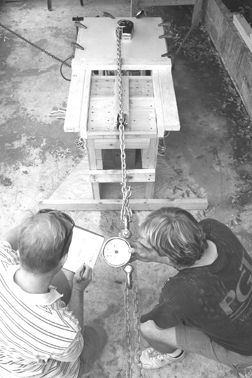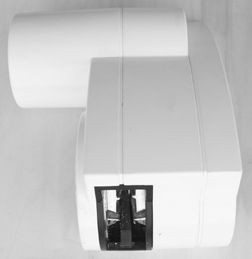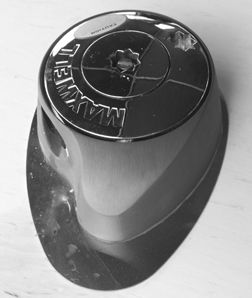
Windlasses are the kind of on-board gear that often receive little attention until they’re needed, and then they’re subjected to the demanding role of freeing anchors from the varied surfaces of the ocean floor below. Electrical windlasses in particular are prone to abuse because they contain an interface of mechanical and electrical components. That’s why PS values rugged windlasses, built to last.
This spring, we conducted the mother of all windlass tests, producing sufficient data for three articles, each focused on a different cost range. This article covers five windlasses under $1,000. We already tested nine in this price range (see PS March ’04). In the accompanying chart, data is shown for those models, with updated pricing info, along with the four new ones. One windlass, the Muir Compact 600, was deleted due to a price increase and will be included in a future report. Another, the Lewmar Horizon 600, was removed because of similarities to its sister windlass that is still listed, the Lewmar Horizon 600 GD.
Future articles will cover bigger and more powerful windlasses suitable for larger sailboats, with prices ranging from just over $1,000 to nearly $3,000.
What We Tested
We added another four horizontals and one vertical to the group of nine we reviewed last spring in our under-$1000 windlass test. Remember, a horizontal windlass usually has all its mechanical gear—including motor, reduction gears, gypsy, capstan, and clutch—in an abovedeck housing, while a vertical windlass usually has only the gypsy, capstan and clutch in an on-deck housing, with motor and reduction gear located belowdecks. Also, the anchor line on a horizontal model only contacts the gypsy for about 90 degrees of rotation before the line drops through the deck port and into the anchor locker. On a vertical model, that contact area extends over at least 180 degrees of rotation, giving the vertical windlass a better grip on the anchor rode.
Lewmar supplied its new horizontal windlass, the Pro-Series 1000, for this test. While Maxwell, last year’s winner with the vertical Freedom 500, sent a recently released horizontal windlass, the HRC 8. We also picked up two additional units from Navimo in Sarasota, FL. This company is a distributor for the Italian-built Quick brand of windlasses. We tested the Genius 1000 horizontal as well as the Crystal 1000 vertical. Rounding out the field was the Powerwinch 40, which is built in Monroe, OH. (We obtained that item through West Marine.)
How We Tested
Every windlass we tested this time around made claims for no-load speed, working load speed, and maximum pull. We used the same test protocols as last time to verify these claims and make it possible to compare products from this test as well as the previous one.
Lewmar, Maxwell, and Quick each supplied an anchor rode for testing their windlasses. We used a New England premium three-strand line of the specified size to test the Powerwinch. We dunked the anchor rodes in a water tank before each test to better simulate real-world anchor pulling. One at a time, each unit was bolted to a square piece of plywood and then clamped to the top of our test stand (see photo at right). The stand was anchored to concrete using both chains and fasteners. All electrical connections were made using the switches, reversing solenoids, and circuit breakers provided with the windlasses. Wires were sized according to the manufacturers’ specifications, or larger. Electrical power was supplied with a pair of new 8D marine batteries hooked to a CSI Speco power supply with the output set at 13.8 volts. This setup simulates a boat with lots of battery capacity and the engine running at idle.
We began each no-load test by stretching about 100 feet of line straight out in front of the test stand and then loading the end into the winch. We placed two marks 50 feet apart on the pavement and set the chain-rope joint on the starting mark. The weight of the chain at the far end held the rope taut. One of the testers made sure the rode continued in a straight line and flowed smoothly onto our lead roller. Then we ran the winch and measured the time it took for the windlass to pull in 50 feet of line. Once we recorded the time, calculations were made to convert the time into feet per minute. With a Fluke 336 ammeter, power usage measurements were taken both at startup and while the anchor line was moving.
Next, we set up for the working load test by pulling the line back off the windlass and coupling the chain to our test load. We measured the speed for 50 feet of travel and recorded the current draw.
During our test last time, we pulled a small boat trailer up a slight incline to simulate pulling an anchor out of the muck. That setup provided a breakaway load of about 200 lbs. and a working load of approximately 100 lbs. This time, we loaded a wooden pallet with bricks and pulled it over flat pavement. When we tested the load with our Dillon dynamometer, it registered an average of about 150 lbs.
Maximum pull testing was done in two phases. First, we tested with rope in the gypsy, and then the chain. We used our dynamometer to measure the load during each pull. To prevent any movement and to obtain good readings, we used the towing pin on a 5,000-lb. forklift that had its drive wheels chocked to secure the end of our anchor rode. Using an additional section of chain, we installed the dynamometer between the forklift and the windlass chain. With rope in the gypsy and a small amount of slack in the line, we ran the windlass until either the rope slipped or the circuit breaker popped, and recorded the maximum reading on the dynomometer. The test was repeated a second time with chain in the gypsy.
Lewmar Pro-Series 1000
The Lewmar Pro-Series 1000 is a horizontal windlass with a powerful 1000-watt motor rating. The electric motor is fully contained with all its reduction gearing in a stainless-steel housing. The case, chromed bronze gypsy, stainless-steel pressure finger and clutch knob are polished to a high-gloss finish. The Pro-Series 1000 is priced at $769. Its 5-year warranty is the longest of any windlass PS has tested to date.
This recently released winch comes packaged with a reversing contactor 70-amp circuit breaker, rocker switch, mounting hardware, clutch lever, and owner’s manual. Instructions include a mounting template that made marking, drilling, and cutting easy. We followed the wiring diagram in the manual to complete installation on our test deck. We found the owner’s manual well documented, with easy-to-follow installation instructions and a number of important operating tips.
We did note one problem during our initial test run. After completing the wiring, we’d operate the unit in both forward and reverse just to check that all connections were tight and correct. When we did that on the Lewmar, it did not operate. We traced the problem to an inoperative circuit breaker. We swapped it out for another working breaker and continued testing.
The Pro-Series 1000 managed a no-load speed of 83 feet per minute (fpm)—good compared to most other windlasses in this test, but below its advertised claim of 105 fpm. Working load speed measured 57 fpm against a claim of 88 fpm. We assign no fault here, as the test conditions used by the manufacturer and those we arranged may have varied considerably. There is no industry standard for such tests. Maximum pull testing exceeded the manufacturer’s claim of 1,000 lbs. using chain. In rope testing, it only reached 440 lbs. as the rope slipped in the gypsy.
Bottom Line: We like the modest price and 5-year warranty of this unit, but its performance was just average.
Maxwell HRC 8
As the first horizontal windlass from Maxwell we’ve tested, the HRC 8 has a motor rated at 600 watts and an aluminum motor/gearcase housing finished with a white, high-gloss powder coating. The housing fully encloses the chromed bronze gypsy and reinforced nylon pressure finger. This enclosed gypsy is a design feature we’ve seen on other Maxwell units. Though the design may limit a user’s ability to clear a jam, it also reduces exposure to moving parts, enhancing safety.

Maxwell ships the windlass with a reversing solenoid, control switch, 70-amp circuit breaker, plastic clutch handle, and an easy-to-read and well-illustrated owner’s manual. The HRC 8 is priced at $920 and carries a 3-year warranty.
Like the other horizontal units we’ve tested, installation was easy. We just followed the mounting template, drilling and cutting the appropriate holes. The housing secures to the deck with three studs that are provided. Electrical hook-ups went well, too, as we followed the wiring diagram in the manual.
Topping the field in speed performance, the HRC 8 hit retrieve rates of 121 fpm with no-load and 90 fpm with the working load we imposed. The no-load speed is above the manufacturer’s published speed of 108 fpm, while the 90 fpm with a load is below the 108 fpm claimed, but is still quite fast relative to the other products in our test.
As we’ve stated before, we don’t hold it against the HRC 8 for not achieving working load numbers, since our test and Maxwell’s are likely different. Maxwell claims a maximum pull capability of 900 lbs. and we were able to exceed that number in both rope and chain maximum pull testing. We hit 1,100 and 1,170 lbs., respectively. Like its vertical cousin—the Freedom 500 (last year’s top pick—the HRC 8 achieves its high retrieve rates by using a lot of electricity. Start-up current draw was in line with some of the other high-wattage units tested at 175 amps, but continuous working load draw was 56 amps, second only to the Freedom 500. The real difference between this and some of the units with lower power consumption is the wiring needed. The initial cost of installing the wiring for a HRC 8 will be somewhat higher because of the larger sizes needed.
Bottom Line: The Maxwell HRC 8 had both the speed and power to garner our top-pick rating despite its larger wiring requirements.
Powerwinch 40
One of a series of new windlasses from Powerwinch, the 40-class windlass is rated for boats up to 40 feet. We picked this one rather than the smaller 35 because it seemed a better fit with the competition and was priced near our $1,000 limit at $999. It’s a horizontal windlass with an automatically operated freefall mode. The motor, reduction gears, and clutch assembly are contained in an aluminum case finished with white polyester powder coating. The gypsy and pressure finger are stainless steel. This unit does not have a manually adjustable clutch.
Powerwinch ships the 40 with a switch, manual, and mounting hardware. Installation of the windlass and its wiring were straightforward.
In speed testing, the Powerwinch 40 recorded a no-load speed of 82 fpm and a working load speed of 56 fpm. Powerwinch makes only one speed claim: a no-load of 75 fpm. In maximum pull testing, the Powerwinch managed a 450 lb. pull with rope in the gypsy and 600 lbs. with chain. It did not meet the Powerwinch claim of 900 lbs.
To operate the freefall mode, you press and hold the down arrow on the control switch. After a few seconds the clutch disengages, and the anchor freefalls. One problem with a freefall system like this is the lack of control. Unlike a manually adjustable clutch that can be let off gradually, the electrically actuated Powerwinch freefall system happens all at once. When tension is on the anchor rope—as it was during our maximum pull testing—the rope release can be violent. The stretchable nylon rope acts like a rubber band stretched out and it snaps back.
Bottom Line: We don’t like the Powerwinch’s freefall system because of its uncontrolled release, and this windlass’s performance was average.
Quick Genius 1000
Quick’s Genius 1000 is the big brother of the Genius 600 we tested last year. Both of these horizontals share many features in construction and performance. All components, including motor, reduction gears, and clutch are abovedeck contained in a brightly finished aluminum housing. A beefy polycarbonate pressure finger is used to control the line in the chromed-bronze gypsy. All the associated electrical components appear to be of high quality. The Genius 1000 carries a price tag of $899 and a three-year warranty.
The 800-watt unit ships with a reversing solenoid, control switch, clutch handle, mounting hardware, and instruction manual. Installation was straightforward and similar to other horizontals. We drilled or cut all holes according to a provided diagram and the unit was secured to our test deck with lugs. Wiring was simply a matter of following the instructions.
Demonstrating similarity in performance to its smaller brother, the very powerful Genius 1000 achieved a 1,520-lb. pull with chain, the highest in our test. It did not, however, reach its advertised maximum pull of 1,984 lbs. In speed testing, the Genius 1000 managed a no-load speed of 62 fpm, well below the claimed speed of 99 fpm, and with our working-load hit 42 fpm.
Steven Paley, president of Quick’s US distributor, Navimo, offered the following comments on the speed-versus-pull compromise: “You should know that Quick, based on its research with boaters all over the world, feels the most important factor in windlass performance is maximum pull. That is the amount of pull the windlass can sustain at the point of anchor breakout from the seabed. In order to maximize this load ability, the motor and gearing are such that speed is sacrificed. Most windlass manufacturers opt for speed over maximum pull for a given motor wattage size.”
Bottom Line: A nice-looking, well-constructed, and powerful windlass with average retrieve speeds.
Quick Crystal 1000
This is the first vertical windlass from Quick we have tested. The chromed-bronze gypsy, heavy-duty polycarbonate pressure finger, and clutch are located above the deck in a highly polished housing. The reduction gears and motor are attached at the bottom and are belowdecks. We found the Quick Crystal 1000 on the web for $924. It carries a three-year warranty.
The Crystal vertical windlass from Quick uses the same 800-watt motor as the Genius 1000. It ships with a reversing solenoid, 80-amp circuit breaker, control switch, clutch handle, mounting hardware, and manual. Installation was simple as the motor and deck housing are contained in one unit and require no assembly. Holes were drilled and cut by following a template taped to our plywood test deck. Wiring was done according to the easy-to-follow diagram in the manual that was shipped with the unit.
Speed performance of the Crystal was better than the horizontal Genius, but still a bit slower than the fastest windlasses in this test. In no-load speed testing, the Crystal 1000 managed 68 fpm, below the claim of 93 fpm. In our working load test, the Crystal hit 58 fpm just about right on the Quick claim of 60 fpm.
The Crystal 1000 is also geared toward a strong pull rather than a fast retrieve speed, as evidenced by its 1500 lb. maximum pull with rope or chain in the gypsy.

Bottom Line: Overall, this is the most powerful windlass in its class. We’d pick this windlass when anchor breakout loads or working loads are high and retrieve speeds are not a major concern.
Conclusions
If your boat can accommodate the machinery associated with a vertical windlass belowdecks, we’d still choose the Maxwell Freedom 500 (from our previous test) in this price range and size. It has high retrieve speeds, quality construction, easy installation, and a good warranty, along with adequate maximum-pull capability.
In a vertical windlass installation, where pulling power is more important than a fast retrieve speed, we’d opt for the brute strength of the Quick Crystal 1000. This windlass is a virtual stump puller with nearly three times the pulling power with rope or chain of the speedy Maxwell.
If you just can’t fit a motor and gearbox belowdecks on your vessel, then a horizontal windlass is the style for you. The Maxwell HRC 8 is our top pick among horizontal windlasses in this size and price range. It sped past all competitors in no-load speed testing and was only a bit slower than the Freedom 500 in working-load speeds. Plus, it has a powerful max pull with either rope or chain, and a three-year warranty. And, it’s also about $70 less expensive.
Also With This Article
“Value Guide: Windlasses Under $1,000”
Contacts
• Lewmar, 203/458-6200, www.lewmar.com
• Maxwell, 714/689-2900, www.maxwellmarine.com
• Imtra (Lofrans, Muir), 508/995-7000, www.imtra.com
• Plastimo/Navimo (Quick), 866/383-1888, www.plastimousa.com
• Powerwinch, 888/699-4624, www.powerwinch.com
































